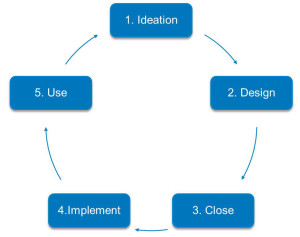The Insight-led Sales Motion

Who can forget Alec Baldwin’s famous line in “Glengarry Glen Ross,” “These leads are for closers!”?
Strong closing skill aside, in today’s world, the seller who waits for leads will be reacting to situations already defined by the buyer and subject to spreadsheet competition facilitated by Procurement and won by the lowest bidder. The most successful sellers today do not wait for situations to be presented to them; they get out in front by executing an insight-led sales motion.

The insight-led sales motion consists of five steps:
#1 Ideation
Working with top executives at the customer, well above the procurement level, who own responsibility for the income statement and the issues that come with it. These executives are open to ideas that will save or make them money by considering business processes from a new perspective, like cloud computing that can offer critical systems and the latest information without the need for big up-front investment in hardware and software. Or the patient monitoring system that enables patients to move out of expensive intensive care units earlier, saving everyone money, without risk. Sellers get a chance to explain how doing things differently can have a meaningful impact on the business.
#2 Design
Working with department executives and their support team to ensure that new processes are configured and provisioned in ways that make both economic and operational sense. This is the opportunity for sellers to teach the users how the new process will work and mitigate the risk of failure.
#3 Close
This is where the vast majority of sales time and resource is deployed today…reacting to leads and RFPs. While this remains a step in the insight-led sales process, the act of closing is influenced if not outright controlled by an executive that cares more about outcomes than cost. This step does not go away. The difference is in who makes the decision and on what basis. Closing depends on making an ROI case, not delivering a price discount.
#4 Implement
New ideas do not get implemented without care and planning. Sellers and their team of engineers/technicians pay careful attention to ensuring that all affected customer personnel are properly provisioned and trained on what to do and how to do it. They care about and are invested in the success of their customer.
#5 Use
The sales team does not fade into the twilight to begin the hunt for the next sale. The seller, aided by service specialists, remains engaged in helping the customer ramp up the new processes, learn about and fix glitches and look for opportunities to deepen the relationship and expand the impact of the new processes. This is why the insight-led sales process is shown as a loop. The time spent learning from the customer about what works best and what needs to be fixed not only helps the seller scale the new processes and sell more, it also keeps the seller engaged in discussing the next big idea with the customer. This brings you back to Step 1 and a whole new sales process.
Next Steps
Insight-led selling has its own challenges. You must have an “engine” that systematically produces insights and product/service packages that are differentiated and meaningful. You need skilled sellers and technical support to deliver the value to top executives at the customer. You need a post-sales organization that is tied into the sales and service ethos. And you need to command a premium price to pay for the time and effort needed to deliver the insight-led selling motion.
But with Alexander Group surveys indicating that between 30 and 50% of the market now demands greater insight from its vendors/partners, it may be time to explore how you can build or enhance your ability to grow and profit from an insight-led sales motion at your company.